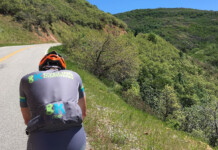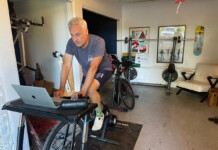Spring is upon us and the calling to put in big miles as winter ends is loud! We’ve got the list of events whether they be races, gran fondos or searching for personal best efforts. The idea of doing a big century ride either in training or one of the many mega endurance rides/races is super appealing yet quite daunting.

an opportunity to ride with a great group of people. This is from the 2014
Tour de Cure, a ride that needs to be on your list. Photo by Dave Iltis
Have you ridden 100 miles before? Wondering if you can? Wonder no more and start making your plans to make it happen. For many the idea of riding 100 miles sounds daunting. Is it doable? Yes! Here are a few tips on making it happen for you.
- Choose your timing – when do I start training? What are your expectations?
- Select some events or dates for your desired performance – look at the calendar and track down events that appeal to you and/or decide on dates for your peak performance
- Consider your time constraints – how much time do you have available for training? • Does that align with your current lifestyle when you consider work, family/relationship, social
- Make sure to allow time for recovery and rebuilding between tough training blocks and post event
- Build your training plan, hire a coach, buy a prebuilt plan for the particular event
- Consider the terrain, time of year (weather/environmental conditions), event elevation as you put together your training
- Consider nutrition and hydration planning
- If this is a pack riding event make sure you are ready to be surrounded by other riders
Ok, let’s get down to the details of the preparation.
Choosing Your Timing
Hopefully you’ve been doing some training through the winter months so you’re not starting from scratch as spring approaches. Even a few days a week through the winter can make a huge difference once you start training in earnest. If your favorite century ride is in April and you haven’t started training it might be one you suffer through to finish.
Part of this comes down to expectations. If you are doing a century in April and you haven’t been riding a lot keep your expectations reasonable and realistic. It may turn out your average speed is much lower than a similar effort in July after your training is making a difference in fitness levels.
In addition, as you start out with training make sure to put things together progressively. It’s tempting to jump right in to 15 hours of training per week if you have the time available. However, you might put yourself over the edge!
Select Your Events and Dates for Peak Performance
Planning out your season is essential for peak performance. Build a calendar of events/dates to help build out your training plan. Having dates in mind adds accountability to your plan and helps with motivation as the training advances.
Choose events that are fun, appealing and challenging! Some of the most entertaining events for me are when a bunch of teammates decide to hit an event together. The anticipation and excitement builds within the group. That’s amazing for motivation!
Consider Your Time Constraints
Nothing stops you in your tracks of motivation than overestimating your time available for training. Be reasonable as you consider the amount of time you have for training. Training for a century ride is doable with limited time. Just make sure you get some long rides in before the big day. Make sure your work/social/relationship schedule can tolerate the time you are planning for training.
Riding big miles will definitely help you with efficiency and fitness. Riding with a purpose is even better. It’s called junk miles versus intentional miles. Pedaling is a good thing. Even steady riding at endurance levels is super beneficial. It drives me crazy when people say they are putting in junk miles. Have your mindset be about purpose when you jump on the bike.
Recovery is When You Get Stronger
Training for big events puts a huge load on your physiology. Training breaks the body down, hopefully with a purpose if you’re following a sound training plan. The days you take off or ride at Active Recovery allow your body to use resources to rebuild rather than work.
The physiology has a chance to rebuild muscle, build more red blood cells, and increase plasma volume in addition to other changes. Remember it’s important to go hard on the hard days and take it easy on the mellow days. Riding at mid-throttle all the time doesn’t provide the big gains over the long haul.
Plan Your Training
Training with a plan provides intention and purpose. You’ll stay more focused on your goals and the particular preparation for your big events. Building out the plan takes some effort knowing where to place the big work as well as making it progressive so you avoid stagnating or overtraining. Programming in rest and recovery is as important as hitting your Tempo and Threshold efforts.
Building a training plan takes some effort. There are plenty of resources out there. Many people have used Joe Friel’s Training Bible books. Hunter Allen and Andy Coggan “wrote the book” on training with power – Training and Racing with a Power Meter. You can take their information and create a solid training plan for yourself. Another option is to hire a coach to help you match up your time constraints with your goals and intentions with a customized training plan. There are also plenty of pre-built training plans available based on how much time you have available and which type of event(s) you are trying to crush.
Further Considerations
There are plenty of other considerations as you lay out a plan for success. Terrain of the event, environmental conditions like temperature and elevation as well as pack riding should play into your training plan.
Terrain for the goal event should go into your planning. Along the Wasatch Front plenty of people look forward to the Ultimate Challenge, the amateur event that follows the Tour of Utah Queen Stage. In years past the event has been as long as 110 miles with 10K feet of climbing. You need to plan for the specifics of your goal event in your training. Whether it be lots of climbing or having some dirt/gravel sections make sure you are familiar with the event demands.
Another important consideration commonly overlooked is adaptation to temperatures you will encounter during your goal events. If you’re planning on having peak performance in July you need to make sure your body is ready to handle hot summer temperatures over multiple hours. It’s definitely more comfortable to train in the cooler temperatures of the morning. However, if you haven’t experienced hard efforts in 90+F until your event you might find yourself in trouble.
Time to Get After It!
It’s time to find your events if you haven’t already. Figure out the calendar, look at the course profiles, think about your time available for training and start to lay out your training plan. Remember there are coaches out there who are ready to build a plan based on your goals and time constraints.
As you start rolling through your training plan you can start practicing your hydration and nutrition plan. These are key aspects to successfully reaching your goals. You don’t want to be surprised with stomach upset or not understanding the caloric demands of your event. You can learn all of this by practicing during your training.
Pack Riding
Finally, if your big day is a pack event you definitely want to know how to ride in the group. Drafting saves energy and allows you to ride faster for longer. Make sure you get out with an experienced group and train your ability to ride in close quarters with large groups. We are all responsible for each other in a pack. If I ride safe, I keep you safe and vice versa. There are many options for group riding.
It’s exciting to be rolling into the new season. Make sure to enjoy yourself along the journey of putting in the big miles. Nothing makes me smile more on the bike than putting out my best effort. Those days happen because of intentional purpose and lots of hard work.
Dave Harward runs PLAN7 Endurance Coaching. PLAN7 offers individualized training plans customized to your goals and time constraints, nutrition programming and metabolic rate testing as well as bike fitting. Dave brings nearly 3 decades of race experience in multiple disciplines and 12 years of coaching and bike fitting experience to the table. Learn more at www.plan7coaching.com












This is super helpful, Dave. Thank you! I’m preparing for my first century ride and it is timely information.
Comments are closed.